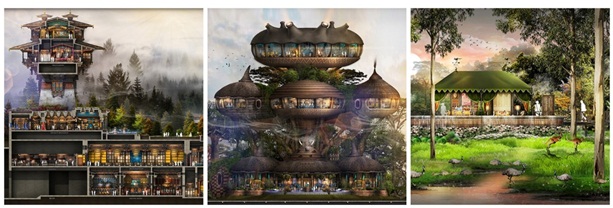Following the creation of the Four Seasons Tented Camp and Elephant Sanctuary in Thailand and his own Bensley Collection – Shinta Mani Wild luxury tented camp in Cambodia, Bill Bensley is currently designing his most ambitious and innovative wildlife conservation concept to date – Worldwild China or as it’s affectionately become known – The (Luxury) Human Zoo.
This exciting “Animals First” concept will prioritize animal welfare while developing unique conservation conscious learning experience for guests and visitors. For the animals it will be place for Respect, Refuge and Rehabilitation while for humans, it is being created for Education, Excitement and Experiences.

Set in 2000 acres in Wuchuan in southern China’s Guangdong province, the wildlife sanctuary and reserve will have 7 luxury hotels with a total of 2000 rooms, scheduled to open in 2020. Worldwild will touch on everything that Bensley is deeply passionate about; sustainability, conservation, wildlife protection, education and unique design.
Background – How it Came About
BENSLEY were approached by their client Dinglong in China, to design a zoo with over 2000 hotel rooms on a piece of land bigger than Central Park. Being curious, Bill was naturally intrigued – but not being a fan of zoos and after visiting many zoos in China, he turned the concept on its head and proposed a wildlife sanctuary and reserve which dedicated 95% of the land for animals to run free and 5% of the land for people to observe and learn about the animals, but stay confined in “jails” or “viewing cages”– in this case luxury hotels. The expected number of guests and visitors each year is up to 10 million.
“It is my dream that the mistreated animals of over populated zoos in China could run free there. Of the 60,000 vertebrates worldwide, we are reassigning non-predator animals from less fortunate Chinese roadside zoos to create an ecosystem where they can all thrive. I am planning a wildlife reserve without cages or predators, as that simplifies the equations significantly. Instead of fences we will use natural barriers to separate species which might not get along: barriers such as rivers, mountains, forests or hahas”, said Bill. (A ha ha is a recessed landscape design element that creates a vertical barrier while preserving an uninterrupted view of the landscape beyond. The design includes a turfed incline that slopes downward to a sharply vertical face).
Three Continents – Asia, Africa and Australia – Seven Hotels and Four Trains
The hotels will be spread across three zones representing the three continents of Asia, Africa and Australia. Asia’s hotels will be called Dzong (228,854 sqm) and Dragon’s Nest (38, 893 sqm) which will be operated by Hyatt. Africa’s hotels will be called The Colony Lodge Hilton (211,272 sqm) and Stone Town Conrad (54,783 sqm).
Australia will have three hotels: the Waldorf Astoria World Wild (101,044 sqm) and the Fish River Settlement by Waldorf Astoria a short distance away (9,570 sqm). Last but not least is Australia’s tented camp, Kamp Koala (10,451 sqm) which will be a Shinta Mani Bensley Collection Hotel.
Dzong (Asia): 734 rooms
Dragon’s Nest (Asia): 97 rooms
The Colony Lodge Hilton (Africa): 850 rooms
Stone Town Conrad (Africa): 109 rooms
Waldorf Astoria World Wild (Australia): 220 rooms
Fish River Settlement by Waldorf Astoria (Australia): 46
Kamp Koala Shinta Mani Bensley Collection (Australia): 28
A total of 2,084 rooms over 654 867 sqm (2000 hectares)
Spas and Wellness
Each hotel will have a luxury spa and while some of the details are still in the works, they will follow the outlines set in Bill’s white paper “Sensible Sustainable Solutions” and will not be importing products from all over the world, but rather using local techniques and ingredients, infused with the character of each hotel depending on the zone in which it is located.
Trains
Worldwild will have four trains which visit all three continents in the reserve. The three luxurious sleeper trains are named the Tasmanian Tiger for Australia, Oriental Expresso for Asia and the African Queen for Africa. Following the head conductor wagon, each train will have 5 cabin wagons with exquisite suites that can accommodate up to 40 guests, a restaurant wagon and an observation wagon.
The fourth train, the Iron Horse, with 6 wagons, will conduct day tours in all 3 continents and will wind around the park and take people to eight different whistle-stops. At each stop people will experience something like an amazing Broadway show, educating them on different aspects of wildlife, environmental protection and sustainability. “I want to set an example that gives animals the respect they deserve.” said Bill.
Top to Bottom: Sleeper Trains – Tasmanian Tiger Train (Australia), Oriental Expresso Train (Asia) and The African Queen Train (Africa) with The Iron Horse for day tours
Storytelling
Bensley is known for his storytelling designs and WorldWild will be no exception with each of the hotels offering a unique experience based on their location in the 3 continents. While no two will be alike in terms of architecture or experience, all of them will focus on the animals which surround the hotels, continuing the idea of a human zoo – albeit a far more comfortable zoo than those many animals call home.
Each of the hotels will have a different story – a DNA BENSLEY follows diligently when designing – based on real history. The Asian hotels are inspired by Bhutan, Ladakh, Nepal and Tibet, which is reflected in the architecture. In Africa the two hotels are inspired by termite colonies and the cliff homes of the Dogon and Telem people. The Australian Hotels are inspired by the Australia Gold Rush and the many types of people who flocked to the area in the search – from Mr Waldorf setting up his second hotel to welcome visitors, to the Fish River settlement (home to convicts and settlers alike, searching for gold) and Kamp Koala, where a naturalist set up camp and welcomed visitors, whom he taught to treat fauna and flora with respect.
Inspiration and Legends
Each part of the hotel was inspired by a different corner of the world which has incredible biodiversity as well as a rich history and vernacular language.
Dzong is a monastic fortress inspired by Bhutan, Tibet, Ladakh and Nepal. It tells the story of a Lama who found a small cave there hundreds of years ago, and who meditated for 3 years before emerging and gathering a following of monks and then built a monastic fortress and welcomed rescued animals, following the Lama’s main teaching: to care for the earth and its creatures.
Dragon’s Nest is based on a legend about seven Bhutanese gods who were all brothers, and rode the skies atop dragons. They chose this peak to settle in and founded Dragon’s Nest, with each brother founding either a palace or monastery. The brothers then returned to the skies to watch over their people, speaking to them through the kings and lamas, their embodiments on Earth.
The Colony Lodge Hilton was inspired by termite colonies, and tells the story of an American explorer who found drawings of a termite village for humans – and sets about building this extraordinary structure, to the bewilderment of locals. The architecture remains reminiscent of termite colonies, while the interiors tell the story of early explorers to Africa.
Stone Town Stone is inspired by the cliff homes of the Dogon and Telem tribes, who built their homes along cliffs, seeking a safe height to escape flash floods. Stone Town is imagined as an epicentre of the spice trade with merchants and explorers from China, India, Arabia and many parts of Africa made Stone Town their home. A true melting pot!
The Waldorf Astoria World Wild was opened by Mr Astor ten years after the New York counterpart, following the burgeoning wealth of the gold mines in the British colony. At its peak it was the grandest dame Down Under, visited by people from far and wide. The war years lay ruin to the main buildings until a renovation in 1968 when she was brought back to life!
Fish River Settlement tells the tale of the most remarkable gold mine in Australia, where the first speck of gold was found in 1823! The local colonial government tried to squash the discovery but failed: settlers, convicts and immigrants flooded to the area to search for gold, creating a village which shared a variety of skills and professions and challenged the authorities to make something of themselves – the Gold Rush diggers were the start of the Aussie spirit!
Kamp Koala was once the exploration base for Naturalist and Explorer William Bensley, who documented the wilds of Fish River. He worked with the earliest Fish River settlers to teach alternatives to hunting, and preserve the local flora and fauna. His camp grew to 28 tents, all working together to treat the wildlife with the utmost respect, and unlearn the bad habits taught for centuries.


















